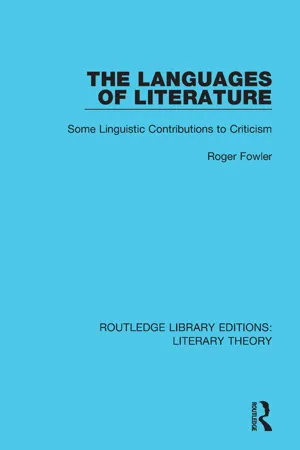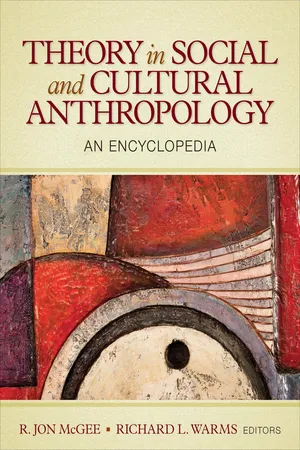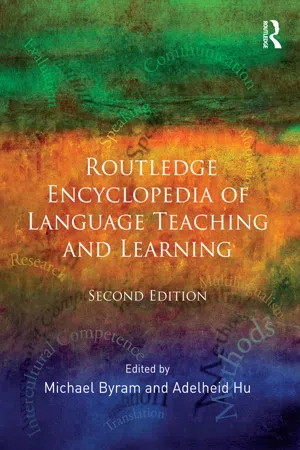Languages & Linguistics
Objective Description
Objective description refers to a type of language that presents information in a factual and unbiased manner, without personal opinions or interpretations. It aims to provide a clear and accurate representation of a subject, often using specific details and sensory language to create a vivid picture for the reader. This type of description is commonly used in scientific writing and journalism.
Written by Perlego with AI-assistance
Related key terms
Related key terms
1 of 4
Related key terms
1 of 3
3 Key excerpts on "Objective Description"
- eBook - ePub
The Languages of Literature
Some Linguistic Contributions to Criticism
- Roger Fowler(Author)
- 2016(Publication Date)
- Routledge(Publisher)
Articulate Energy (London, 1955) suffers from inadequate attention to the demands of objectivity. I do not say that he should have used the term ‘syntax’ strictly in accordance with usage among linguists at the time, although there is of course much in favour of using words in non-idiosyncratic senses; simply, central terms with analytic pretensions should be defined more clearly and rigorously than was the case in that important book.One has to acknowledge the impossibility of exact statement of linguistic meaning, perhaps especially so in literature, although I do not take ‘ambiguity’ to be absolutely defining.4 We weigh probabilities, and linguistic analysis, far from being a key to certainty, is only one tool for helping us organize, formulate, and communicate our thoughts. The aim in descriptive criticism may be to discover and propose convincingly what one believes to be the ‘correct’ interpretation, but what is achieved is an interpretation, or a statement of alternatives, which through objectivity in the sense given here can provide a basis for informed argument and evaluation.It seems that the complaint is not against objectivity in this sense but against the ‘triviality’, ‘tediousness’, ‘barbarous jargon’ of a full analysis. My point in Essays on Style and Language, repeated more than once, was that, because of the delicacy of linguistic analysis, great detail is possible—Professor Sinclair’s essay demonstrated that—but may not often be required. Linguistic analysis of any school applied in totality is a kind of machine which may, one day, be able to turn up all the answers to questions about the grammatical, phonological, and lexical levels of literature. The machine needs a master; as Mrs Vendler says, ‘A method is only as good as the intelligence using it ….’ Professor Halliday condemns ‘ad hoc, personal and arbitrarily selective statements … in support of a preformulated literary thesis’ (Proceedings of the Ninth International Congress of Linguists, ed. H. G. Lunt (The Hague, 1964), 302), but I consider the hunch to be essential and precipitating, and the linguistic analysis to be a subsequent process, explanatory and confirmatory. (Cf. John Spencer and Michael J. Gregory, Linguistics and Style - eBook - ePub
Theory in Social and Cultural Anthropology
An Encyclopedia
- R. Jon McGee, Richard L. Warms(Authors)
- 2013(Publication Date)
- SAGE Publications, Inc(Publisher)
Alex François Alex FrançoisMaïa Ponsonnet Maïa PonsonnetDescriptive Linguistics Descriptive linguistics184 187Descriptive Linguistics
Descriptive linguistics (henceforth DL) is the scientific endeavor to systematically describe the languages of the world in their diversity, based on the empirical observation of regular patterns in natural speech.Definitions
The core principle of DL is that each language constitutes an autonomous system, which must be described in its own terms. Modern descriptive linguists carry out detailed empirical surveys on a language. After collecting language samples from speakers, they analyze the data so as to identify the components of the system and the principles that underlie its organization. Through its commitment to the empirical description of speakers’ actual practices and to the diversity of languages as creations of linguistic communities, DL is closely allied with the social sciences.The research agenda of DL can be contrasted with a number of related yet distinct approaches to language. Anthropological linguistics and sociolinguistics study, each in its own way, the interaction between cultural or social factors and language use; by contrast, DL focuses on the structural properties of the languages themselves. Historical linguistics studies the diachronic processes of language change, whereas DL focuses on the synchronic forms taken by a particular language at a given point in its development. The endeavor to compare individual languages, and the search for potential universals, is known as linguistic typology. - Michael Byram, Adelheid Hu(Authors)
- 2013(Publication Date)
- Routledge(Publisher)
Findlay and Nathan (1980) , a behavioural objective must meet the following criteria:- the student must be the subject;
- behaviour or performance to be learned must be defined by an action verb;
- conditions must be described under which the student will demonstrate what is learned;
- a minimum level of performance required after instruction must be indicated, as specified by a criterion-referenced measurement strategy.
Behavioural conceptions of objectives thus only accept observable actions as learning outcomes. This could lead to a merely technical perspective on language teaching and learning and to an atomised view of language learning and use. Behavioural objectives should be complemented by other instructional objectives relating to open attitudes, motivation, strategies and general engagement in language and cultural learning; special learning opportunities and experiential objectives should be provided, for example by establishing direct contacts with speakers of the target language communities and by linking languages among each other and to other, non linguistic subjects (cf. Beacco et al., 2010 ). The assessment of this type of objective is yet a difficult question.Content aspects
Depending on the understanding of the nature of language and its acquisition and of the general aims of education, the content of aims and objectives changes.In addition, the general philosophy underlying education at a given time or place must be taken into account since it influences the way the roles of the teacher (e.g. model of knowledge or facilitator of the learning process), the learners (constructing their language competence or receiving and assimilating knowledge and skills, for example) and teaching materials are conceived. Richards (2001)
Index pages curate the most relevant extracts from our library of academic textbooks. They’ve been created using an in-house natural language model (NLM), each adding context and meaning to key research topics.
Explore more topic indexes
Explore more topic indexes
1 of 6
Explore more topic indexes
1 of 4


